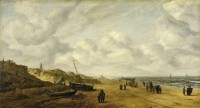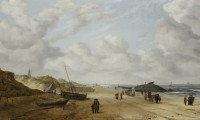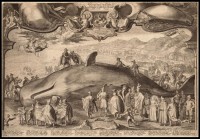[youtube=http://youtu.be/hMgUPTbqih4&w=430]
View of Scheveningen Sands by Hendrick van Anthonissen seemed like an unassuming beach scene when conservator Shan Kuang first began to work on it. Painted in 1641 and donated to the Fitzwilliam Museum in 1873 along with a group of other Dutch landscapes by patron Richard Kerrich, View of Scheveningen Sands was sent to the museum’s Hamilton Kerr Institute for conservation while the Dutch Golden Age gallery was closed for a year-long refurbishment. Its resin varnish coating had yellowed over time, so Kuang was tasked with removing it to freshen up the painting for the grand reopening of the gallery.
 Kuang began to painstakingly clean the canvas. Her work soon revealed an incongruous lone figure of a man standing on the horizon. There was only sea underneath him and sky above, so it was unclear how he fit into the composition. More cleaning of the area next to him exposed a dark grey triangular shape, which led Kuang to speculate that the man might be in the rigging of a sailboat that had been overpainted. She could see that the ocean in that spot was more crudely painted than in the rest of the painting.
Kuang began to painstakingly clean the canvas. Her work soon revealed an incongruous lone figure of a man standing on the horizon. There was only sea underneath him and sky above, so it was unclear how he fit into the composition. More cleaning of the area next to him exposed a dark grey triangular shape, which led Kuang to speculate that the man might be in the rigging of a sailboat that had been overpainted. She could see that the ocean in that spot was more crudely painted than in the rest of the painting.
After much discussion with Hamilton Kerr conservation experts and Fitzwilliam curators, they decided the overpaint was not the work of van Anthonissen. Its thick impasto and inferior quality indicated a later alteration done in the 18th or early 19th century. By the time the painting was donated in 1873, nobody knew it had been overpainted. Removing it was still a risky prospect. It’s difficult to take away just the paint layer that was added without harming the original paint, and you never know what ugly surprises might be concealed by the overpaint.
 They decided to take the plunge, and Kuang set about removing the thick overpaint with a scalpel and a few carefully chosen solvents. To ensure she didn’t damage the original, she viewed the work under the microscope. Under the paint she found not a ship, but a beached sperm whale.
They decided to take the plunge, and Kuang set about removing the thick overpaint with a scalpel and a few carefully chosen solvents. To ensure she didn’t damage the original, she viewed the work under the microscope. Under the paint she found not a ship, but a beached sperm whale.
The man who seemed to be standing on the horizon is, in fact, balanced on the whale’s back where Kuang suggests that he might even be measuring its length.The chosen focus of the painting resonates with a surge of public interest in whales: contemporary records show many instances of whale beaching on the coastline of the Netherlands in the first half of the 17th century. While the Anthonissen painting seeks to represent the whale in a realistic manner, some prints from the period portray whales as rampaging monsters of the deep and omens of disaster.
 Realistic depictions of beached whales and viewing them as omens of disaster was not mutually exclusive. The Dutch Republic in the late 16th, early 17th century was experiencing the religious and political upheaval of the Eighty Years’ War, a period that coincides with the heyday of the beached whale in Dutch art, literature and political writing. The appearance of a whale was seen as a portent of defeat in battle or a sign of God’s displeasure at the prospect of a truce between religious factions. A 1602 engraving by Jan Saenredam of a beached whale at Beverwijk has a long Latin note underneath detailing the exact measurements of the mammal (60 feet long, 14 feet high, 36 feet in circumference, 14-foot tail, 12-foot lower jaw) while above the tableau is a frame of allegorical references to earthquakes, eclipses and the passage of time. There are also more anatomically correct details of the whale after decomposition gases caused it to explode and Death shooting Amsterdam with a plague arrow.
Realistic depictions of beached whales and viewing them as omens of disaster was not mutually exclusive. The Dutch Republic in the late 16th, early 17th century was experiencing the religious and political upheaval of the Eighty Years’ War, a period that coincides with the heyday of the beached whale in Dutch art, literature and political writing. The appearance of a whale was seen as a portent of defeat in battle or a sign of God’s displeasure at the prospect of a truce between religious factions. A 1602 engraving by Jan Saenredam of a beached whale at Beverwijk has a long Latin note underneath detailing the exact measurements of the mammal (60 feet long, 14 feet high, 36 feet in circumference, 14-foot tail, 12-foot lower jaw) while above the tableau is a frame of allegorical references to earthquakes, eclipses and the passage of time. There are also more anatomically correct details of the whale after decomposition gases caused it to explode and Death shooting Amsterdam with a plague arrow.
By the time Anthonissen painted his beached whale landscape, the trend was losing steam. Negotiations between Spain and the Dutch Republic began in 1646, and a Treaty formalizing Dutch independence was signed in 1648. The prophetic vision of beached whales no longer bedeviled the stable, confident Republic. With the interest in the subject long faded, someone decided to hide the dead whale altogether, perhaps to make it more palatable to a wider market as an innocuous beach scene.
View of Scheveningen Sands, with a Stranded Sperm Whale is now on display in the reopened Dutch Golden Age gallery of the Fitzwilliam Museum.
These beaches still look similar: In particular, I loved the passage where they had identified the dude with the fin as ‘kite-surfer’. What I found is that, during his journey to the Low Countries, A. Duerer was staying in Antwerp (in 1520, Nov 22th – Dec 3rd), and according to his report(**):
“At Zierikzee in Zeeland a whale has been washed ashore by a great tide and storm; it is much more than a hundred fathoms long; no one in Zeeland has ever seen one even one-third as long, and the fish cannot get off the land. The people would be glad to see it gone, for they fear the great stink, for it is so big they say it could not be cut in pieces and the oil got out of it in half a year.”
A real pitty is that there is apparently no surviving sketch from this, but there is one from the Antwerp harbour. Zierikzee is about 45km south of Scheveningen. Of course, it remains highly questionable what kind of ‘fathoms’ he was referring to. ** A PDF of the (german) manuscript is available for download, but to find and decipher the exact passage is hard work.